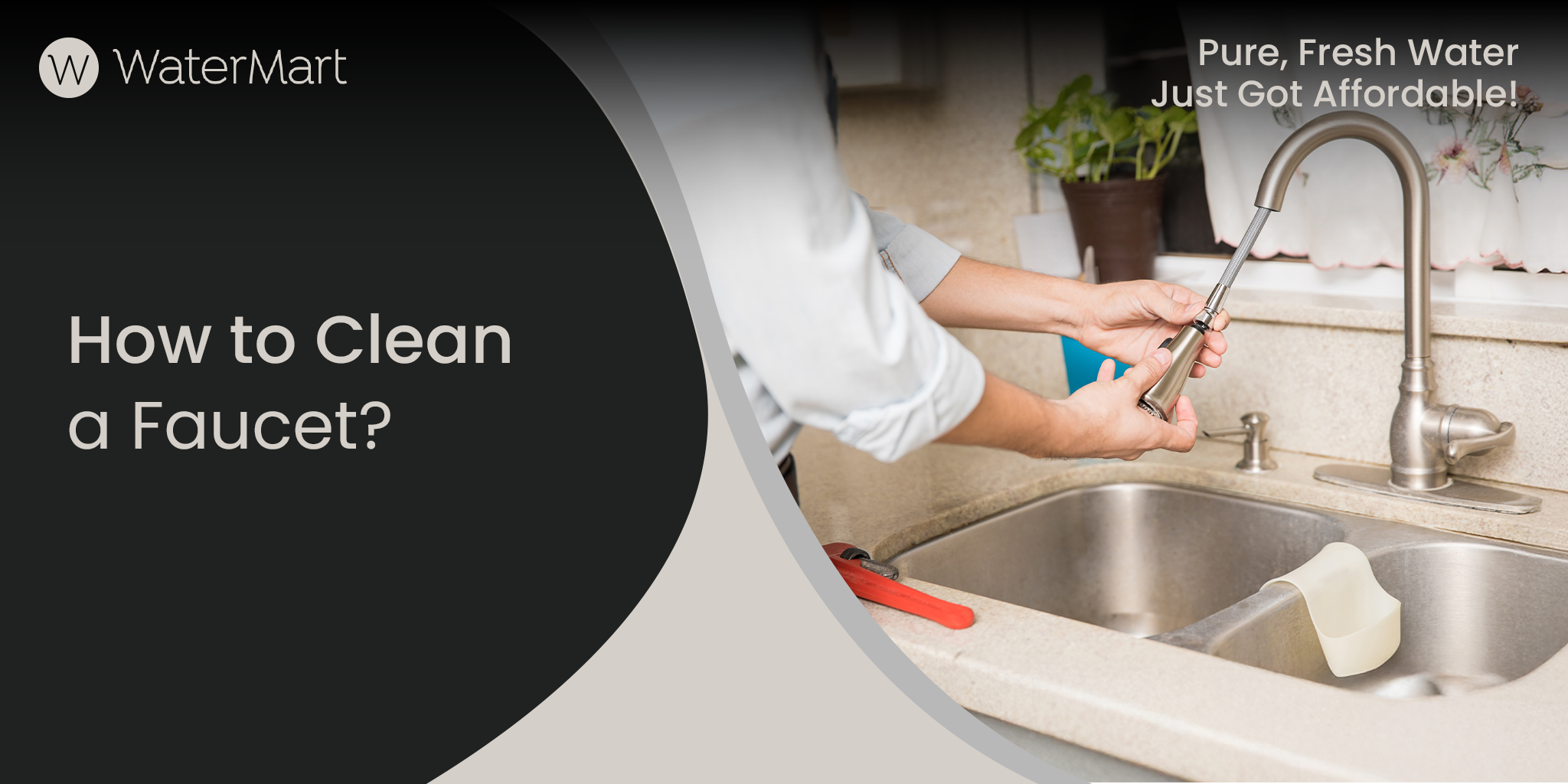Your cart is currently empty!
How To Clean And Disinfect Faucets? Kitchen & Bathroom Faucets Cleaning Steps!
Not keeping a faucet clean affects water hygiene, causes mineral buildup, and lessens the durability of the fixtures. In most households, different faucets have different types of residue on various fixtures. For example, the kitchen faucet has marks of grease, food particles, or splatter from cooking.
Whereas, the bathroom faucet deals with more soap scum, toothpaste, and hard water marks around the base and knob. Knowing how to clean and disinfect faucets properly helps protect your water quality and prolong the life of your fixtures.
Wiping down is only the first step. Other steps, like stopping mineral buildup or addressing water flow issues, are also necessary.
This guide breaks down the most useful DIY methods, including vinegar, lemon, baking soda, steam cleaning, and commercial cleaners. Read and find out how to get rid of grime properly.
How To Clean a Kitchen Faucet?
After prepping meals, especially anything greasy or raw, the kitchen faucet is left coated in splash marks, food grime, and streaks. For basic upkeep, use a microfiber cloth to wipe the faucet, being careful to get at the base and knob, after combining dish soap with warm water. If you leave it wet, water spots and residue set in fast.
Deep Cleaning Methods
Need deep cleaning methods? All of these will take less than 30 minutes and offer shiny faucets.
Vinegar Soak
This method is best for hard water deposits and limescale, but only if your fixture’s finish can handle acidity. Use this method on a clean faucet made of stainless steel, as it will take off gold or bronze finishes.
- Tools: White vinegar, ziplock bag, rubber band, toothbrush, and cloth.
Steps:
- Fill the bag with a 50:50 solution of water and vinegar.
- Submerge the faucet head.
- Secure it using the rubber band, and soak for 30-60 minutes.
- Remove and use the toothbrush to remove any loosened grime.
- Then, run water to clear the hardware.
- Dry fully to protect the coating.
Baking Soda Paste
Apply this to thick dirt surrounding the base or knob, food stains, and stubborn grease. It’s a versatile faucet cleaning method for both stainless steel and bronze finishes!
- Tools: Baking soda, small bowl, water, and toothbrush.
Steps:
- Add half a cup of baking soda and a full cup of water to a bowl.
- Mix it until it has a paste-like consistency.
- Then apply it directly over the residue.
- Wait for 15 minutes and then use a soft-bristle brush to scrub it slowly.
- Finish by washing it with warm water and drying with a cloth to prevent streaks or spots.
Steam Cleaning
Regardless of the faucet’s finish type, steam works the best for getting rid of stubborn buildup. It’s great for chemical-free sanitization for modern kitchen faucets.
- Only two tools needed: a Handheld steamer and a soft towel.
Steps:
- Fill your steamer with water and let it heat.
- Hold it about 10-15 cm away from the faucet and sweep slowly across the surface.
- A tip is to always focusing on the knob, base, and neck.
- Do not put long blasts near any plastic component.
- Think it’s spotless? Use a cloth to dry everything and wipe away loosened grime or calcium.
Lemon Rub
Use this for quick shine, odor removal, and light lime or calcium buildup. It’s a simple fix for minor spotting or dullness, especially when used with baking soda paste!
- Tools: Half a lemon and a soft cloth.
Steps:
- Take a whole lemon and cut it from between.
- Rub the sliced cut lemon directly on the faucet, especially where you see water marks or buildup.
- Let the juice sit for 5-10 minutes. The citric acid works well on light residue without damaging the coating.
- Then wipe down with a damp cloth, followed by a dry one for a polished finish.
Commercial Cleaners
When natural methods don’t cut it, especially with visible corrosion, a store-bought cleaner can help.
- Tools: CLR, Bar Keepers Friend, or Lysol Bathroom Cleaner (all available in Canadian stores), rubber gloves, and a cloth.
Steps:
- Always wear gloves to protect your hands, especially if you’re using chemical-based cleaners.
- Read the label and apply per instructions.
- Next, test a mild amount of cleaner on a small spot of the faucet.
- If it reacts, change the cleaners; if it doesn’t react with hardware, follow the next steps!
- Apply it all over and scrub it off lightly with a cloth.
- Then rinse the faucet thoroughly with water and dry it with a clean cloth.
How To Clean a Bathroom Faucet?
The bathroom faucet accumulates residue from toothpaste and soap film, especially in shared spaces. For quick daily cleaning, simple dish soap or disinfecting wipes can be used to break down buildup. Always wipe and dry the surface for a spotless bathroom faucet.
Deep Cleaning Methods
For deep-set grime or dullness, skip the above cleaning method. Here, we’ll cover targeted methods using lemon, steam, and more.
Lemon and Salt Scrub
For natural cleaning methods, you can use lemon and sodium. Use this when there’s visible grime or buildup that basic soap doesn’t lift. If your finish is sensitive, test on a small surface area first.
- Tools: Half a lemon, coarse salt, and a cloth.
Steps:
- Cut a lemon in half and dip the cut slice in salt.
- Rub the mix directly onto the faucet.
- Add extra on stained spots and around the knob.
- Let it sit briefly to break down calcium or soap film.
- Wipe clean with a damp cloth.
Toothbrush Detailing
The faucet has various tight gaps that are hard to reach. The bristles on the toothbrush can reach the tough spots, especially around hardware’s base, spout, or back of the sink. We recommend doing this method after a shower, as moisture would’ve softened the buildup.
- Tools: Old toothbrush, dish soap or vinegar, warm water.
Steps:
- Dip your brush into warm-soapy water or a vinegar mix (see above how to make a paste).
- Slowly scrub around the faucet joints, handle, and any crevices where grime settles.
- Wash it off with water and don’t forget to dry it fully to avoid the formation of new spots.
Steam Cleaning
Use this when dealing with rust, hardened mineral buildup, or fixtures that haven’t had proper TLC in a while.
- Tools: Handheld steamer, soft-bristle brush, towel.
Steps:
- Steam the faucet head at close range.
- The heat will loosen stuck-on deposits.
- Then use a brush or non-scratch sponge to lift away the gunk.
- This works well for how to clean faucet corrosion and even on how to descale kitchen faucet style buildup, without damaging the finish.
- Always dry the hardware to prevent further rust.
Disinfecting Step
Even with regular cleaning, bacteria can build up around the knob and spout. Disinfecting weekly is recommended, especially in shared bathrooms or high-traffic households.
- Tools: Disinfectant spray, clean cloth.
Steps:
- After doing any of the above methods, wait for the faucet to dry.
- Next, spray a light mist of disinfectant directly onto the surface.
- Let it sit for the labeled contact time, then wipe dry with a cloth.
How to Clean Faucet Aerators?
A blocked aerator is the cause of weak water flow or an uneven spray. Faucet performance gets lower as dirt, lime, and mineral deposits accumulate behind the screen over time. To clean the part without breaking your faucet, use this easy method.
What You’ll Need
- Soft cloth (to prevent scratches while removing the handle)
- Toothbrush or soft brush
- Small bowl
- White vinegar
- Rubber band, plastic bag (optional for soaking without removal)
- Access to the drain area
Cleaning strategy
- Unscrew the aerator from the faucet spout using your hand. If it’s tight, grip it through a cloth to protect the finish.
- Close or cover the drain so you don’t lose any small parts or the screen.
- Then, submerge the component in the vinegar solution for 30 minutes.
- If you can’t remove it, use the above-given “vinegar soak” method to soak the aerator directly.
- Scrub thoroughly with a toothbrush to clear out trapped debris, salt, or soda-like scale inside the screen.
- Wash fully, dry all parts, reassemble the aerator, and test the spray.
That’s all you need on how to unclog a kitchen faucet. A clean aerator improves flow, reduces internal buildup, and restores even water spray. This quick method extends the faucet’s lifespan and keeps drain issues away.
Preventive Maintenance Tips
- Keep a microfibre cloth for keeping the faucet dry after each use to reduce lime or calcium buildup.
- Never use abrasive tools like steel wool, coarse sponges, or gritty powders, as they wear down the protective coating.
- Don’t use cleaners with strong acid content like hydrochloric, phosphoric, or caustic agents. Use mild citric or acetic acid only for acid-resistant materials.
- Skip bleach-based products, metal polish, or anything labeled “tarnish remover”.
- Don’t submerge any faucet parts like soap pumps or aerators. This can weaken internal seals and create leaks.
- Clean the aerator once a month for better spray performance and even flow.
- Once a week, use a mild soap or vinegar-based mix to clean the surface, then rinse and dry properly.
Still Dealing with Faucet Buildup? Here’s What to Do Next
Daily quick cleaning, weekly deep cleans, and monthly aerator maintenance are all the faucet requires for best performance. Keeping your faucet clean is easy, and it doesn’t cause the parts to fall off. But if all of the above methods don’t work and you see severely rusty parts, it’s time for replacement. For low-maintenance options that hold up long-term, explore WaterMart’s full range of kitchen and bathroom faucets.






